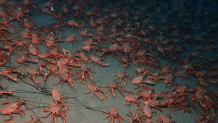Tuna crabs have been swarming San Diego's coast in recent months.
Dr. Charlotte Seid, manager of the Benthic Invertebrate Collection at the Scripps Institution of Oceanography at UC San Diego, said thousands of these interesting visitors have been turning up at La Jolla Submarine Canyon, a popular scuba diving spot. Although they are a native species, tuna crabs are usually seen southwest of San Diego near Baja California in Mexico.
"It's not entirely alarming, but it has been unusual to see them in these numbers year after year," Seid told NBC 7.

Get top local stories in San Diego delivered to you every morning. Sign up for NBC San Diego's News Headlines newsletter.
According to Seid, tuna crabs have been occasionally washing up in San Diego in large numbers since a marine heatwave event that began in 2014 and lasted until 2016. It is believed the crustaceans get swept up from Mexico during El Niño events and other disruptions.
"It's not that the crabs are deliberately making their way to us," Seid said. "They live in those waters and get swept up sort of like birds outside of their migration route, and they find their way to California, even further north than us."
Seid says scuba divers have the best chance to see the tuna crabs since the crustaceans tend to be at depths of 40 to 100 feet.
"There was a stretch for a few weeks where they were coming up to shallower depths around 12 feet, so brave snorkelers and free divers could come see them," Seid said. "Historically, there have been times where they accidentally wash on shore, so anyone at the beach here in La Jolla could have seen them."

These crustaceans are distantly related to the types of crabs and lobsters that people eat, according to Seid. They got their name by being a favorite food source for large species like tuna when they live out in the open ocean.
Local
Seid described tuna crabs as "opportunistic eaters," feeding on what they can find, including other local invertebrates and, sometimes, each other.
"If they run out of food, they'll eat other tuna crabs, and they themselves are a prey for other local species," Seid said, adding that she's seen octopus and rock crabs eating them. "San Diego's ecosystems have recovered year after year from previous arrivals of tuna crabs."
If you happen to come across a tuna crab or any other unusual wildlife or marine life sighting, Seid said you can upload a photo to iNaturalist — a citizen science platform — and receive input from scientists and naturalists from around the world who can help identify the creature. The data collected goes into a database used by Seid and other citizen scientists.



